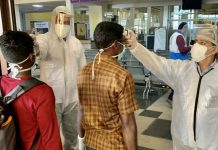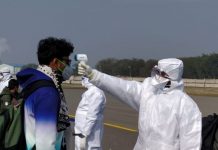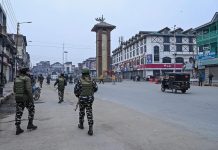 The past week has witnessed visits of many a minister from New Delhi to Jammu and Kashmir, most of them going to Jammu than Kashmir Valley. And almost all of them pronounced the end of militancy in the troubled union territory and the beginning of the new phase of peace and development.
The past week has witnessed visits of many a minister from New Delhi to Jammu and Kashmir, most of them going to Jammu than Kashmir Valley. And almost all of them pronounced the end of militancy in the troubled union territory and the beginning of the new phase of peace and development.
Clad in Kashmiri pheran, the communications minister Ravi Shankar Prasad visited the North Kashmir town of Baramulla and inaugurated an indoor stadium. However, in their meetings in the Valley, the ministers were generally kept away from the common people. The functions they attended were largely confined to government employees. In Sopore town in Baramulla district, an entire area was sealed off to facilitate Prasad’s visit.
Out of the planned 58 meetings in the newly created UT, only eight are scheduled in Kashmir Valley and the rest in Jammu. Similarly out of 36 ministers who visited the UT, only five came to the Valley.
The objective of the visits, some of them still ongoing, is to make people aware of the advantages of revocation of Article 370 which granted J&K special status under Indian Union. The ministers are also here to share the new development initiatives taken by the government.
However, as is evident from the structuring of these visits, they were not geared to adequately address the grievances in Kashmir Valley, which has been hit the hardest by the security measures taken by the government in the wake of the abrogation of Article 370. Also, the visits of ministers made little redeeming difference to the existing state of lockdown.
Interestingly, Prasad’s visit to Baramulla didn’t lead to any relaxation in the internet shutdown in the district. It was only two days after his visit that the government moved to 2G internet on mobile phones in entire J&K and also broadband service with severe curbs on its still in place including the ban on social media.
“Lingering communication blockade has brought life to a halt over the past six months” says Waseem Samad Parray, a resident of Baramulla. “We expected that the arrival of ministers would be preceded by the removal of communication curbs. But this didn’t happen”.
Similarly, the major leaders including the three former chief ministers – Dr Farooq Abdullah, Omar Abdullah and Mehbooba Mufti — continue to be under detention. And there’s little hope they’ll be released anytime soon. This, in turn, has stopped any political activity in the UT. Not a single political rally has taken place over the past six months. There’s also bar on peaceful protests.
“It hardly helps if the ministers come all the way from New Delhi to inaugurate an indoor stadium or a water scheme but leave Kashmir as it is so far as the larger siege is concerned,” says Naseer Ahmad, author of Kashmir Pending. ”Only Confidence Building Measure that Kashmiris could appreciate now is the complete lifting of internet gag”.
But as things stand, that is unlikely to happen in near future. The government has restored 2G facility to entire Kashmir Valley, but the people think that may not serve real purpose of an internet facility.
“What purpose will 2G serve when the signal is not powerful enough to open a proper website. How will students study and so many other ordinary people ply their daily work online” says Parray.
However, considering so few ministers came to Kashmir as against Jammu, the outreach wasn’t focussed on the Valley. J&K observers think that the barrage of ministerial visits was basically meant for Jammu, a BJP bastion for the past six years.
“The fear of losing land and jobs after the withdrawal of Article 370 followed by lingering communication curbs have affected the political standing of the BJP in Jammu,” says Naseer Ahmad.
letters@tehelka.com












